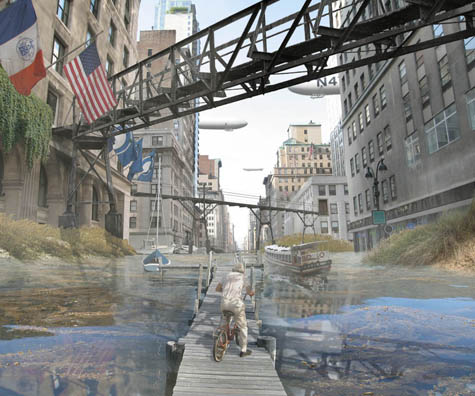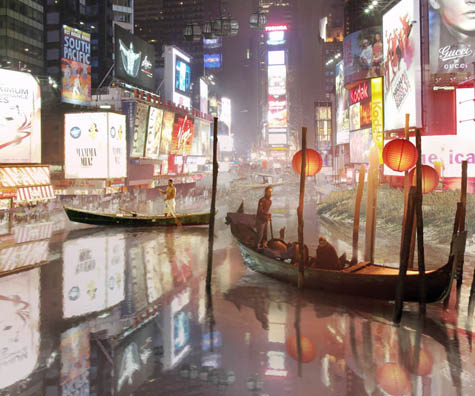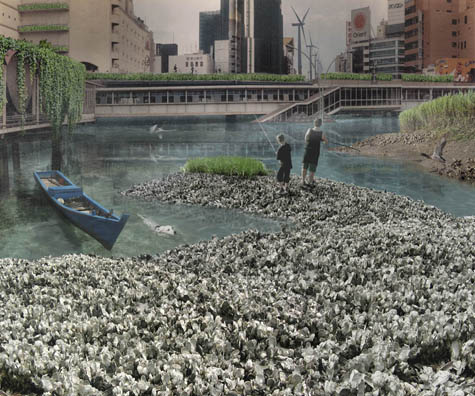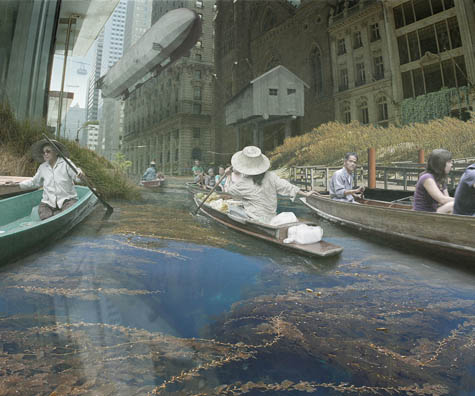 [Image: “Aqualta: 5th Avenue & 35th Street, NYC,” by Studio Lindfors; view larger].
[Image: “Aqualta: 5th Avenue & 35th Street, NYC,” by Studio Lindfors; view larger].
Studio Lindfors—of Cloud Skippers and Cloud City fame—have released a stunning new series of images, published here on BLDGBLOG for the first time, in which we see New York City and Tokyo after a catastrophic flood.
 [Image: “Aqualta: Garment District, NYC,” by Studio Lindfors; view larger].
[Image: “Aqualta: Garment District, NYC,” by Studio Lindfors; view larger].
Called Aqualta, the project is an exquisitely produced tour of a hydrologically transformed metropolis. Gondolas float through a still-blazing Times Square; people fish atop gravel banks that have built up beside inundated skyscrapers; and an aerial network of blimps, catwalks, pedestrian skyways, and cable cars passes and sways above the Venetian streets.
I can’t emphasize enough how beautifully detailed the images are; I’ve put them into a Flickr set for closer viewing. They knock me out.


 [Images: “Aqualta: Times Square at Night, NYC,” “Aqualta: Roppongi Minato-ku, Tokyo,” and “Aqualta: W. 29th Street & Broadway, NYC” by Studio Lindfors].
[Images: “Aqualta: Times Square at Night, NYC,” “Aqualta: Roppongi Minato-ku, Tokyo,” and “Aqualta: W. 29th Street & Broadway, NYC” by Studio Lindfors].
Similar in spirit to Squint Opera’s earlier look at a Flooded London, Aqualta is hard—if not impossible—to separate from the context of melting ice caps and global climate change. However, it deserves visual attention in its own right, even outside such politically charged discussions.
Far from stoking fear about a coming catastrophe, both of these projects—Studio Lindfors and Squint Opera—offer a vision in which people, and the cities they live in, have learned to adapt to the overwhelming presence of water. Indeed, Times Square, in Studio Lindfors’s vision, is radiant, markedly improved by the reflective waters that now flow through it. Of course New York should be at least partially flooded, one might be tempted to think; of course the future of urban planning involves designing with water.
 [Image: “Aqualta: Shibuya Station, Tokyo,” by Studio Lindfors; view larger].
[Image: “Aqualta: Shibuya Station, Tokyo,” by Studio Lindfors; view larger].
In fact, there’s a memorable, if brief, scene in Steven Baxter’s recent novel Flood—a surprisingly thought-provoking book about a global flood that, in Wikipedia‘s words, “even covers Mount Everest in 2052, submerging all landmasses on Earth”—where we see a character scraping barnacles off the rocky sides of New York high-rises after the city has been lost to the sea. South Manhattan has been transformed into a tidal world of mussels, clams, and seaweed—and, even then, the waters continue to rise. But if that novel were ever to be adapted for film, I’d unhesitatingly suggest that Studio Lindfors’s visual firepower be snapped up for art direction and set design.
 [Image: “Aqualta: 5th Avenue & 53rd Street, NYC,” by Studio Lindfors; view larger].
[Image: “Aqualta: 5th Avenue & 53rd Street, NYC,” by Studio Lindfors; view larger].
The architects got in touch after reading the urban premise of DJ /rupture‘s new album with Matt Shadetek, mentioned a few days ago; in an interview with New York magazine, /rupture says the new mix “paints a picture of New York 40 years in the future, where the water line is at the fourth story of buildings and the rich people are dry in the Catskills. Kids are making music on their cell phones and grilling octopi. So, it’s postapocalyptic, but not necessarily grim.”
Again, check out the images in more detail.
Looks like something William Gibson might have dreamed up. Very cool!
Very nice. I especially like the Indiana Jones on the poorly constructed pedestrian bridge
Houseboat living, except the houseboat is a skyscraper.
That white doggy sure gets around.
Stunning pictures!
Reminds me of "Hotel Polonia" from last year's Venice Bienale..Dystopia reversed by beauty..
I seriously doubt the signs in Times Square would be working if the city was flooded.
What's with the birds, i noticed that they're almost in every picture. Like Hitchcock movies
the images are very beautiful and seductive, but what is behind this impulse to adopt the aesthetic of disaster and third world precariousness with none of its messiness? i like the lack of grimness, but the canoes on 5th ave prompt a whole set of questions that are not addressed. there are places where people use these canoes in their daily life, what does it mean to insert them now in such a symbolic place? there is a decision in using this language [vs., say, sailboats or kayaks which is would exist in the northeast, even if old and rotted after the catastrophe], and i'd like to understand the argument behind these choices.
Sometimes it looks like buildings in Schuiten and Peeters french comics, like "La tour" or "l'archiviste".
This kind of virtual collages get this low-tech thing that still works in architecture since Peter Cook and others.
Reminicent of James John Pron's Philapocalypse. Which I belive is now on display in Philadelphia's city hall council rooom, now that it's gallery show is over.
http://philadelphia.going.com/event-378206;John_James_Pron_PHILApocalypse#
where is the real project?
What comes after these images ? just more images ?
I would be nice to read their actual theory if they have one.
The images bring to mind one of the excellent music videos of Yello. (To The Sea)
No idea of light, some perspective mistakes… i don't like it…
i think as a vision they are wonderful. sure details and context are lacking, but the thought of such a scenario unfolding on streets we now walk upon is quite necessary and refreshing. i like.
Yes, there is nothing quite so beautiful and tranquil as a flooded city, we LOVED it in N.O..
Next time maybe you could shake the canvas a little and recall the beautiful fuzziness of 1906 S.F.
When i look at these i think immediately of Noahs arc and how the world was flooded. Back then it was fear and destruction but in these photo manipulations and paintings it holds a sense of beauty. My favorite one that holds the most interest and beauty is the night time lantern and sign lit china city. All of the reflections are perfectly don not to crisp but wavy like water make them.
As crazy as it is to see parts of a city flooded, permanently. It is a positive reinforcement to see that we have adjusted to the conditions of our making, with rice fields, swimming holes and bridges to deal with the change.
Very cool.
the little boats, the people with the hats… looks like southeast asia instead of japan. ignorance or intentional?
i think if the author could have tried a little bit harder to imagine how real japanese people may react, it would have been more interesting.
I'm tired of the grim post-industrial depictions… this is wicked.
These would be good posts the for "Photoshop Disasters" blog.
For dramatic photographs of the 1910 Paris flood, see http://www.ParisUnderWater.com.
Leonardo da Vinci envisioned such a circumstance himself in his sketches of "Codex B" in 1490. A city with two circulation networks– one below with the water, and another above for pedestrians. It's a shame photoshop didn't exist back then.
um…am I being weird and depressing – or is this stuff (while excellent artistically) kind of pollyanna? I mean – what's up with the positive spin on disaster? If this were to be reality, i think you'd see a lot more starvation, disease and anarchy. Maybe I'm just being a jerk today, so here's a smiley 🙂
Ana Maria raises the most interesting objections in my opinion, although I'm not sure I like the lack of griminess. It's all a bit neat – not just because of any message it gives, but because it makes it harder to believe in, harder even to be seduced by, imagine, dream with therefore. Drowned cities in fiction have often been both grimy and dreamily seductive, so why not in doctored photo? I'm thinking of The Drowned World, much of Volodine, maybe even that extraordinary original, After London. However, I still like these, and add a link to a similar venture from some while back, though a uchronia, rather than future fantasy: http://www.forgottenfutures.com/library/venice/venice.htm
Great! After many of our friends and family died, we could still enjoy the miraculously still lit times square and receive vaguely Asian hats! Hey, if these guys had any guts they would have done a New Orleans simulation of this dreamland. Send those hats down to the dome. This blog is great but this stuff is fluff.